Asian Small-clawed Otter (Aonyx cinereus) is one of five otter species found in Asia (Foster-Turley 1991). They belong to the class Mammalia, order Carnivora, family Mustelidae, subfamily Lutrinae (Soffer 2001). A. cinereus differs from other otter species in that their claws are very tiny and the toes are only partially webbed (Soffer 2001).
They have body length ranging from 45 to 61cm, tail length from 25 to 30cm and weighing about 1 to 5kg (Soffer 2001). They have long bodies, short and rounded ears, short legs, long and thick tails at the base and flattening out to the tip. Their fur is short and dense. The upperparts are dark brown or grayish-brown, with under parts that are slightly paler (Payne and Francis 1985). Their chin, throat, cheeks and sides of neck are buffy.
Asian Small-clawed Otters have unusual hand-like front paws with increased tactile sensitivity and reduced webbing, which they use to forage for their prey of crustaceans, mollusks, small fish and other small aquatic animals (Foster-Turley 1991).
Otters are unique in the family of carnivores due to their adaptation to, and love of, aquatic life (Belardo 2001). They dwell in swampy mangroves, freshwater wetlands and lazy streams. They can dig their own dens in riversides, but also make use of the abandoned dens of other animals, or dense vegetation for shelter (Soffer 2001).
Asian Small-clawed Otter is mono-morphic, in which males and females have almost the same morphology. They breed as monogamous pairs, which mate for life (Soffer 2001). The female is the dominant partner and both parents raise the young. Otters can have up to two litters of pups a year, with a gestation period of 62 days. The pups’ eyes open at about 30 days and they start learning how to swim at two months. The young stay with their parents with which they form the core of a small social group.
In 2004, A. cinereus was categorized as Near-threatened by IUCN (Hussain 2004) but due to increasing threats its status turned to Vulnerable after four years (Hussain and de Silva 2008). Philippine Wildlife is protected under RA 9147 or known as the “Wildlife Act” which prohibits the collection of this species, its by-products and derivatives, except for scientific breeding or propagation purposes in accordance with Section 6 of this act. A person who will be caught collecting, hunting or possessing wildlife and their by-products and derivatives shall have imprisonment of six (6) months and one (1) day to one (1) year and a fine of Ten thousand pesos (P10,000.00) to One hundred thousand pesos (P100,000.00), if inflicted or undertaken against vulnerable species.
BE ONE OF THE CONSERVATION ADVOCATES!!!

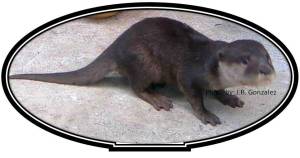
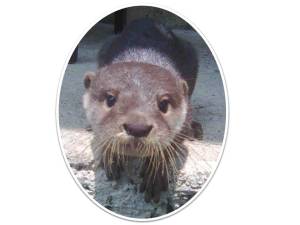
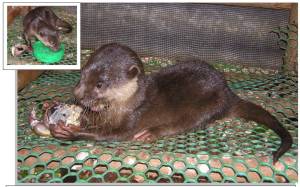
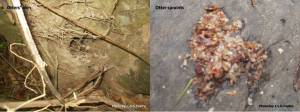

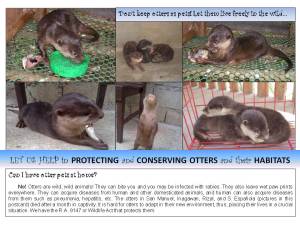
Thanks for reading and for the like vhieve0610 🙂
Hi Ms. Castro — thank you for putting up this website, I posted a link from my blog at http://www.lolako.com. I’m hoping for updates and to learn if anything new is happening for Philippine sea otter so they do not become extinct in the Philippines.
Dear Lola Jane 🙂
It is inspiring to receive comments and emails… Thank you for reminding me that there are people reading my blog who wish to learn more about otters in Palawan, Philippines. I would really like to apologize that I wasn’t able to post updates for more than a year. I am not really good in blogging and just learn how to start it from Otter Specialist friends in Singapore. I wasn’t able to open it for a long time and have already forgotten my password and have just reset it now. I will try my best to post updates on my blog soon… Thank you and God bless your interest in Otter and Wildlife Conservation!
I would just like to correct maam lolakojane that what we have here in Palawan, Philipines is not a sea otter. We only have one otter species – the Asian small-clawed otter. In the Philippines, mostly they live near small streams and rivers but they can also be found along the beach, mangroves, coastal areas and they also visit man-made habitats like rice fields and fishponds.
Thank you for the clarification, Ms. Castro, I have updated my blog post to reflect this information (and again, so glad to see you are back “on”: and look forward to more post. 🙂 and following your blog.